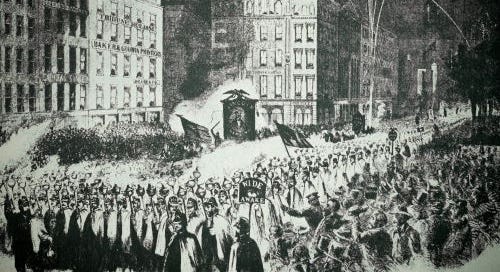By Vix Burgett-Prunty
The 2025 anti-Trump and anti-Musk protests revealed mass dissent’s explosive potential and its contradictions. While their tactical weaknesses diluted power, these uprisings also created critical ruptures: disrupting business-as-usual, exposing state violence, and forging new fronts of solidarity. Drawing on Saul Alinsky’s Rules for Radicals and Paulo Freire’s Pedagogy of the Oppressed, we dissect both the failures and the fertile ground they laid for revolutionary struggle.
Illustration of a Wide Awakes march in New York City, October 3, 1860, from Harper’s Weekly. / Courtesy Internet Archive, Public Domain
Disruption as Pedagogy
Freire teaches that "any situation where some prevent others from engaging in the process of inquiry is one of violence" (Pedagogy of the Oppressed). The protests’ greatest strength was forcing the public to confront systemic violence, not just the racism under Trump’s and his sidekick Musk, but the machinery enabling them.
Where they succeeded:
In Portland, rioters shut down a Tesla delivery hub for 12 hours, costing Musk an estimated $2M in delays (Alinsky’s Rule 1: "Power is not only what you have but what the enemy thinks you have").
Chicago cops brutalized white protesters outside Trump Tower, a rare moment where liberal media had to acknowledge state violence (Freire: "The oppressor consciousness tends to transform everything surrounding it into an object of its domination").
Jail solidarity efforts in NYC bailed out 150+ arrested comrades, creating infrastructure for future repression resistance (Alinsky’s Rule 8: "Keep the pressure on" via mutual aid).
But Freire warns, "Wailing against the oppressor changes nothing." Without sustained organization, these wins remain scattered sparks.
The Dangers of Symbolic Resistance
Alinsky’s Rule 3 ("Go outside the enemy’s experience") was ignored where protests relied on permitted marches. Contrast:
D.C.’s "Million Morons March" stayed in designated zones, ignored by elites.
Oakland’s ungovernable bloc blockaded a Musk-owned lithium mine, linking his wealth to Indigenous dispossession. A Freirean "generative theme" that radicalized bystanders.
No coordinated "attack" on a single pressure point (e.g., mass pickets at Musk’s SpaceX launches to demand Gaza solidarity).
The Freirean Litmus Test
Freire condemns "false generosity," allyship that performs guilt without redistributing power. The protests revealed stark divides:
Failures: European American"allies" in Minnepolis outnumbered Black organizers but didn’t join the next week’s rent strike against Trump-linked landlords.
In Atlanta, European American anarchists diverted arrest risk by locking down in front of Black youth during police charges, a tactical application of Freire’s "authentic solidarity".
Alinsky’s Rule 11 ("The price of attack is a constructive alternative") demands protesters become builders:
Occupying a Tesla factory is good. Organizing its workers into an illegal union is better.
From Protest to Power: A Blueprint
Freire’s praxis (reflection + action) demands we study lessons:
Target chokepoints, not personalities
Musk’s empire relies on Starlink’s Pentagon contracts. Blockade their HQ.
Trump’s wealth hinges on NYC tax breaks. Occupy City Hall until revoked.
Turn grief into grids of resistance
Use arrest hotlines from the protests to seed neighborhood defense networks.
Redirect crowdfunded bail money to permanent jail-support collectives.
Let the oppressed lead (at the very least let the oppressed issues lead)
Freire: "Only the oppressed can liberate themselves." White "allies" must take direction, not headlines.
Rupture Is the First Word, Not the Last
The 2025 protests were a necessary rupture, but as Alinsky warns, "The threat is usually more terrifying than the thing itself." To move beyond terror to transformation, we need:
Study groups that turn protest crowds into class-conscious formations.
Hit where it hurts (Musk’s subsidies, Trump’s loans) with precision.
Build communes in the cracks of their crumbling system.
The riots were practice. Revolution is the final exam.
What are your priorities?
Citations
Freire, Pedagogy of the Oppressed: On "false charity" vs. "co-liberation" (Chapter 1).
Alinsky, Rules for Radicals: "The real action is in the enemy’s reaction" (Rule 4).
Ruth Wilson Gilmore, Abolition Geography: "Organize the irreplaceable" (i.e., attack supply chains).
Los Angeles Tesla Strikers (2024): "They ignore your signs. They can’t ignore your sabotage."




